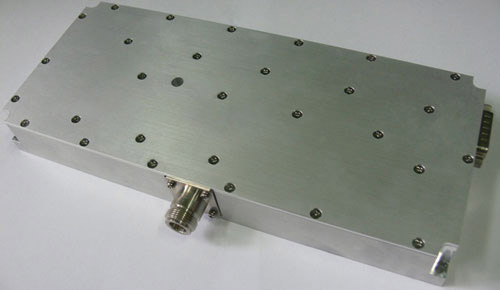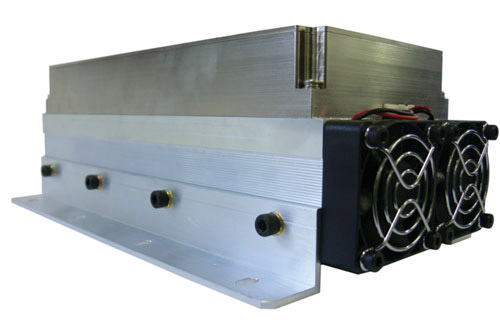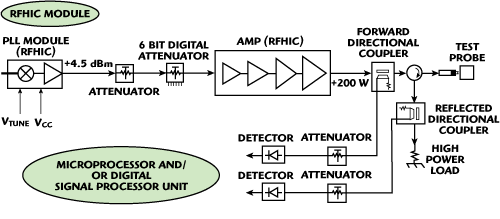 There is a great deal of interest in using RF technology for cancer treatment. Research has offered hard evidence that this technology works and has advantages over traditional medical surgery. Recent research from major medical centers has prompted the observation that Radio Frequency Ablation (RFA) treatment has proven to be the most effective and safest approach to destroying inoperable early-stage cancer.
There is a great deal of interest in using RF technology for cancer treatment. Research has offered hard evidence that this technology works and has advantages over traditional medical surgery. Recent research from major medical centers has prompted the observation that Radio Frequency Ablation (RFA) treatment has proven to be the most effective and safest approach to destroying inoperable early-stage cancer.
RFHIC, which is well known as a manufacturer of active RF and microwave components and hybrids for the wireless telecommunication and instrument markets, is also supporting the medical sector with high performance RF amplifiers. The company recently released the RFMA245 RF amplifier for hyperthermia treatment and RF ablation.
AMPLIFIER CHARACTERISTICS
This highly efficient power amplifier uses a frequency of 2.3 to 2.5 GHz, has an output power of 100 W and a four-stage amplifier design producing 31 dB gain. These power amplifiers can be scaled by combining multiple amplifiers to achieve 1 kW. The final stage amplifier has 55 percent efficiency when operated at Class AB amplification. When using the power amplifier for Class E amplification, the efficiency reaches 90 percent.

Figure 1 RF Amplifier Module.
The final amplifier product is provided in two form factors. One is the RF amplifier module, which is shown in Figure 1. The size of the power amplifier module is 270 X 150 X 40 mm. The picture shows the amplifier with an isolator and low pass filter designed within the amplifier itself. For cancer treatment, the RFMA245 RF power amplifier can be built on a small system and is customizable to suit the specific treatment.

Figure 2 RF Amplifier with fan.
The other form factor is shown in Figure 2. This option includes the heatsink and fan system to the amplifier; the size of the amplifier system is 270 X 150 X 100 mm. In both form factors the RFMA245 RF amplifier includes continuous wave (CW) and pulse signal generation Phase Lock Loop (PLL), so it does not need any additional RF input.

Figure 3 Block diagram of the RFMA245 RF power amplifier.
Multiple protection methodology, including a forward power detector, reflection power detector, a microcontroller unit (MCU) to control alarm features and an external fan control system for temperature control, remotely monitor and control the power amplifier. A 31.5 dB range, 0.5 dB step digital attenuator and linear high power gain compensation circuit for 0 to 100 W per 5 W steps are designed to control the gain and maintain the power of the amplifier. An additional RF on/off switch, isolator, low pass filter and temperature compensation circuits are incorporated within the amplifier. A block diagram of the RF amplifier is shown in Figure 3.
FOUR-STAGE AMPLIFICATION

Figure 4 Four-stage RF amplifier pallet.
The key amplification is carried out via the four-stage power amplifier pallet. The size of this internal pallet amplifier is 207 X 61 X 22 mm and is shown in Figure 4.
This pallet amplifier uses Gallium Nitride on Silicon Carbide (GaN-on-SiC) technology. The core design is dual push-pull in a symmetrical configuration that is very robust against back power or other hazards, which improves reliability significantly.
Patented packaging technology, eutectic bonding, wire-bonding, internal matching and multi-stage amplifier designs are utilized in the design to amplify the original signal 1,000 or 100,000 times (30 to 50 dBm) to get power of 200 W. RFHIC has also designed additional isolators, couplers and connectors to produce 100 W RF power from the output port. Higher power can be achieved by combining multiple pallet amplifiers.
GaN-on-SiC TECHNOLOGY
GaN-on-SiC is the driving technology behind the amplifier. GaN has evolved from the laboratory to real RF and microwave power amplifiers and is gaining market share over other technologies. GaN device technology provides high efficiency, broad bandwidth coverage, good reliability, high operating voltage, high operating temperature and high in/output impedance, which all add benefits for the next generation of instruments.
Early stages of cancer treatment often use this effective RF technology to treat patients. Cancer cells will be destroyed at temperatures of 42°C or higher. Exposing the cancer cell to an RF power signal will increase the temperature and destroy the cancer cell without significantly affecting normal cells.
During the medical operation, the cancer cell may change its RF impedance by more than two orders of magnitude. It is critical to maintain and control the operation while a patient is exposed to RF ablation. By applying GaN-on-SiC technology to the medical amplifier, the variable output load, which in this case is the cancer tissue, can be continuously and stably destroyed. RF power can be applied for a length of time without any problem, due to the rugged characteristics of GaN, which is a significant safety factor.
MEDICAL RESEARCH
Numerous medical tests are currently being undertaken to study the implementation of RF technology and many medical institutes are applying it to treat patients. One of these institutions, the Samsung Medical Center, has demonstrated a significant success rate across 3,600 cases of liver cancer patients for the ten years from April 1999 to April 2009. Over that period the team performed RFA treatment 3,594 times on 2,600 patients. They screened 570 early-stage cancer patients and tracked how well they were doing after the treatment. As reported to the European Radiology Society, the one-year survival rate was 95 percent, the three-year survival rate 70 percent and the five-year survival rate 58 percent.
FUTURE DEVELOPMENTS
Following the introduction of the RFMA245 RF amplifier, RFHIC considers the next stage of development to target various other medical instruments. Smaller equipment can be built using the higher power density characteristics of GaN. Higher polarization voltage gives lower current for the same power output and less Joule effect losses, which provides cost saving in thermal management.
The ability to withstand a higher junction temperature also results in more robust devices and improved lifetime and better mean-time-to-failure (MTTF) can be expected. Ultimately, less cooling will be necessary, which will bring down the size and cost of the system. Finally, other medical frequencies such as 5.8 GHz and existing ISM band products are being studied with key partners in Europe.
RFHIC Corporation
Suwon, Korea
+82-31-250-5011
e-mail: rfsales@rfhic.com
www.rfhic.com
RS No. 300
